The Power of Storytelling

If someone asked you to think of a company that offers the ability to rent someone’s home when when you travel instead of staying in a hotel, which is the first one you would name?
While there are many brands that fit the profile, it’s likely you’d name Airbnb first. Why? Not because it’s the biggest. (HomeAway actually has twice the amount of annual gross bookings.) Not because it’s been around the longest. (Airbnb is actually one of the newest.)
It’s because they’re the best storyteller in the industry.
Most vacation rental brands approach their marketing from the same angle:

“Look how many listings we have!”
“Look how many cities we’re in!”
“Look how popular we are!”
It’s true: Companies like HomeAway and TripAdvisor have a significant edge over Airbnb in certain areas (such as revenue and number of listings) due to their longevity and acquisitions. However, when you look at growth, Airbnb dominates and has organically expanded faster in the past few years than most of their competitors combined.
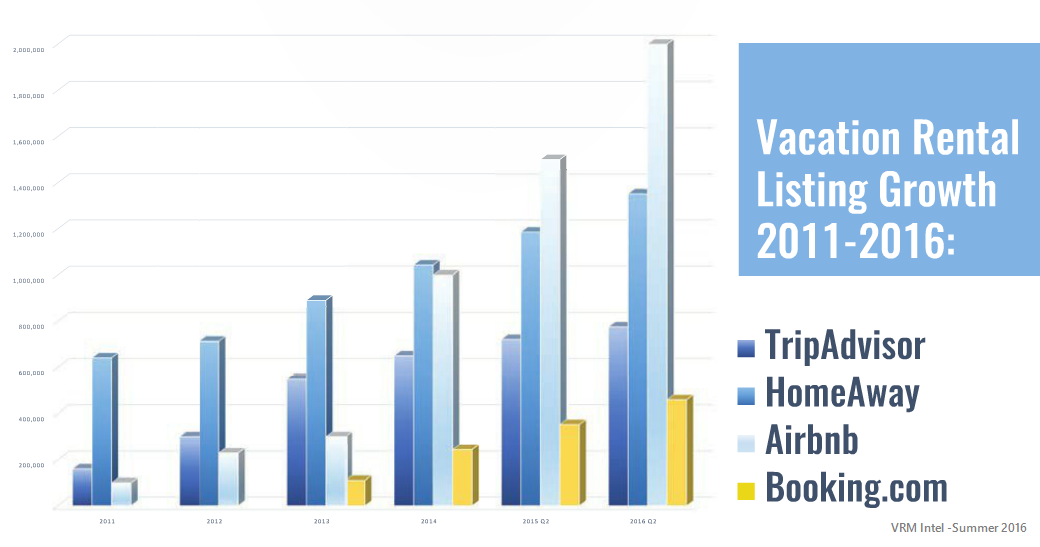
Source: VRMintel
This hockey-stick growth is the result of a number of factors: timing, market disruption, strong leadership, a smart business model, strategic decisions, great UX, and more. Perhaps one of the biggest contributors to their success is that they’ve mastered the skill of storytelling.
What Makes a Good Story?
Storytelling for business is different than storytelling for fun. As your team is trying to figure out how to develop a story that communicates the value your products and services provide, make sure you’re focused on these 6 qualities.
(Note: These tips apply to crafting stories both internally and externally. Getting buy-in and internal alignment is just as important – if not more – than marketing to customers, so make sure you’re spending just as much time socializing your brand story within your walls as you are outside of them.)
Your story should communicate what makes you unique, not a “me too” message.
The last thing your customers need is more of the same. They’re already bombarded with thousands of marketing messages each day. What are you saying to stand out from the noise?
Determining your differentiators requires taking an honest look at your competitors and peers (even if you don’t think they’re a threat). What stories and messages are they using? What unique space can you own in your audience’s mind?
Without honing in on at least one key characteristic that is both unique from your competitors and relevant to your audience, you’re bound to end up as part of the noise instead of standing out from the crowd.
Your customers are already bombarded with thousands of marketing messages each day. What are you saying to stand out from the noise?
Your story should resonate with the needs and wants of your audience, not your business.
Whether it’s a new marketing campaign, website redesign, or product idea, you always embark on a project with a goal in mind. Most of the time, that goal is business-related: Drive sales. Increase revenue. Improve engagement and retention.
These types of goals are crucial to ensure your efforts stay focused and your company stays profitable. However, those objectives can’t be the sole focus.
When business goals are prioritized over audience needs, your product will only get so far. The irony of brand strategy and design is that meeting long-term business goals is only possible when you put the audience’s needs first.
The irony of brand strategy and design is that meeting long-term business goals is only possible when you put the audience’s needs first.
Your story should be about one big idea, not multiple points.
When you start telling a story to a friend or colleague, you automatically start thinking about all the different pieces you want to remember to share. Companies often take the same approach in their marketing and fill their story with as many features, benefits, and cool bits of information as possible.
Unfortunately, when you try to tell someone everything, they end up remembering nothing. That’s why the big idea is so important. It’s the heart of your brand strategy: the one concept or idea you want people to remember. It’s even more powerful when that one thing differentiates your business from your competitors.
When you try to tell someone everything, they end up remembering nothing.
Your story should convey the why, not the what.
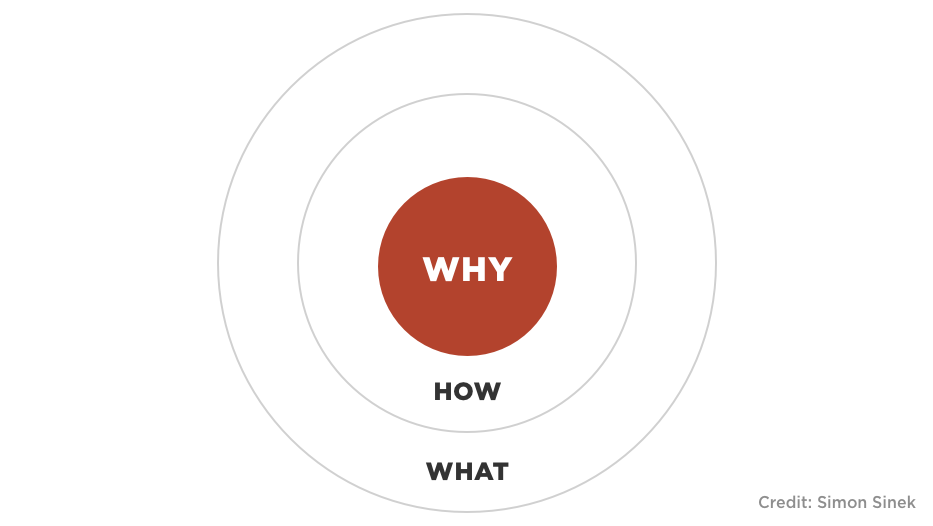
Painting a prettier picture may seem like the smart way to go, but your brand will be far more likely to attract likeminded customers and avoid pitfalls if you just stick to the truth.
Simon Sinek has drilled into every marketer’s head, “People don’t buy what you do; they buy why you do it.” The most effective marketing often doesn’t even mention one cool feature or nice benefit – it’s all about the deeper purpose and the overall experience. Simon Sinek has drilled into every marketer’s head, “People don’t buy what you do; they buy why you do it.” The most effective marketing often doesn’t even mention one cool feature or nice benefit – it’s all about the deeper purpose and the overall experience.
Steve Jobs was the master of this technique. For example, in the late 1990s and early 2000s, brands like Dell, Intel, and Sony came out with slick MP3 players and promoted all their cool features, like hundreds of megabytes of memory and cool design.
Meanwhile, Apple was focusing their marketing around their deeper why of “thinking different” – a far cry from Dell’s “Easy as Dell” and Intel’s “Intel Inside.” Thinking differently was something people not only wanted – they connected with it and had to have it.
Then, Apple launched the iPod with a simple story that focused on the overall experience: 1000 songs in your pocket. That one story not only catapulted the product to success, but changed the whole industry.
People don’t buy what you do; they buy why you do it.
Your story should reveal your authentic brand, not put on a pretty façade.
It’s normal to want to put a pretty spin on a brand that isn’t all that sexy or interesting. However, the truth is bound to come out, and the consequences are far more dangerous than just being honest in the first place.
Take Volkswagon, the fun, quirky car brand that always did things a little differently. Their story seemed a little took good to be true: A cool car that ran on diesel fuel, but didn’t pollute the environment. Unfortunately, this pretty story was covering up the fact that VW was rigging the car’s on-board software to show lower pollution levels and mask the reality of their fuel – a move that would eventually cost the company billions in legal fines and even more in reputation damage.
Painting a prettier picture may seem like the smart way to go, but your brand will be far more likely to attract likeminded customers and avoid pitfalls if you just stick to the truth. And with a good writer, you can find the right words to make that truth just as sexy and engaging.
Painting a prettier picture may seem like the smart way to go, but your brand will be far more likely to attract likeminded customers and avoid pitfalls if you just stick to the truth.
How to Craft Your Story and Brand Strategy
The qualities above may seem simple to achieve, but they’re easier said than done. If you’re not sure where to start or you’re struggling with refining your story, try one of these eye-opening exercises.
Empathy Mapping
Design thinking starts with empathy. Empathy maps help teams better understand their users by brainstorming audience feelings, influences, tasks, pain points, and goals. Repeat this exercise for a typical user in each of your customer segments, then think about how to position your product in a way that resonates with their emotional wants and needs, rather than focusing on features and benefits.
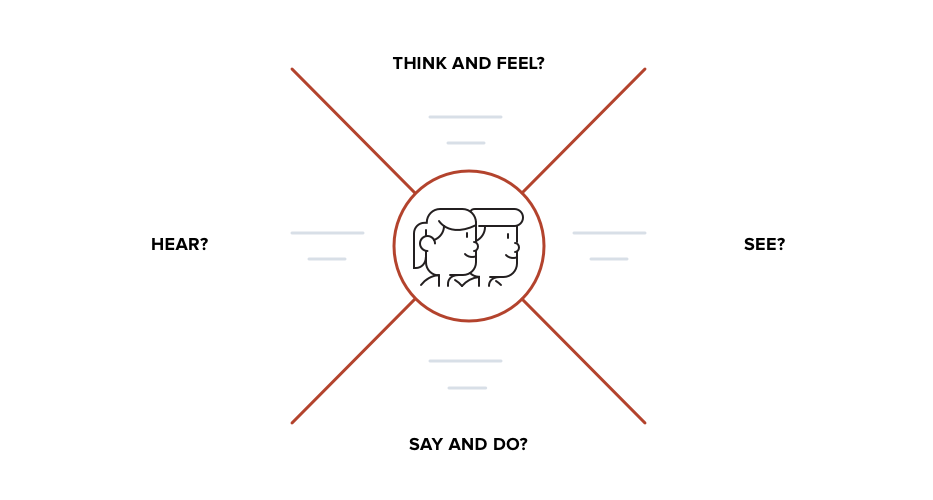
A Sample Empathy Map
The Five Whys
This technique was originally used in the manufacturing world to explore the real causes of an underlying problem. It has the same benefits in UI/UX design and storytelling.
Think of why a typical customer chooses to buy your product. Then, ask “Why?” five times to get to the deeper reason, which could be a prime idea for your brand story.
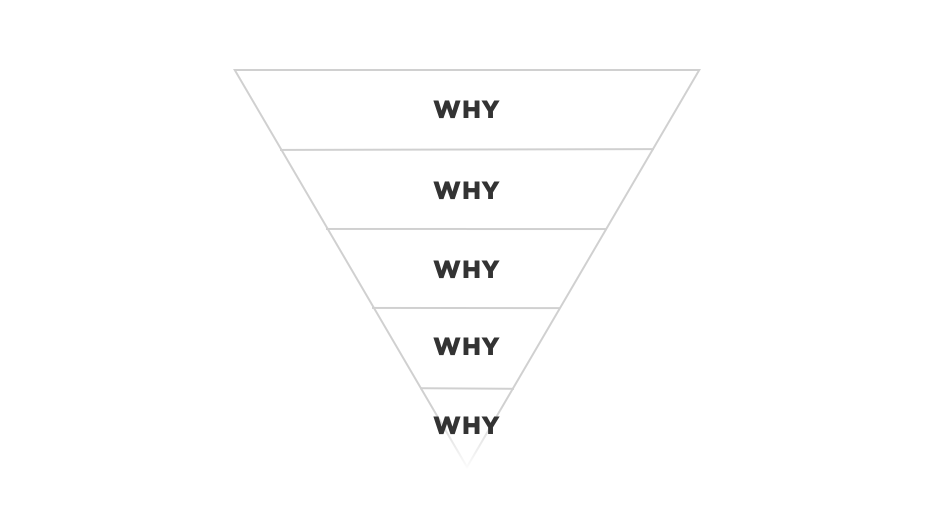
For example:
Why does someone purchase a project management tool? To make it easier to manage multiple products.
- Why would this product improve their experience? Because they’re having a hard time keeping track of everything.
- Why would it be great if they could keep track of everything? Because then they wouldn’t feel so overwhelmed.
- Why would it be great if they didn’t feel so overwhelmed? Because then they could actually spend more time on strategic thinking and important tasks, rather than day-to-day management.
- Why would it be great if they could spend more time on strategic thinking and important tasks? Because then they would be able to produce better results and think proactively instead of reactively.
- Why would it be great if they could produce better results and be proactive? Because then they could actually feel confident and fulfilled in their work.
By digging deeper with this exercise, you end up with a much more compelling message about the real reason a customer chooses your product over others (confidence and fulfillment), rather than tactical, less interesting features that anyone could say (easy project management).
Differentiation Matrix
Determining your brand’s key differentiators always proves more challenging than expected. We all think our products are unique, but can the average consumer tell the difference? Using a differentiation matrix helps parse out what truly makes your company unique and what your customers care about most.
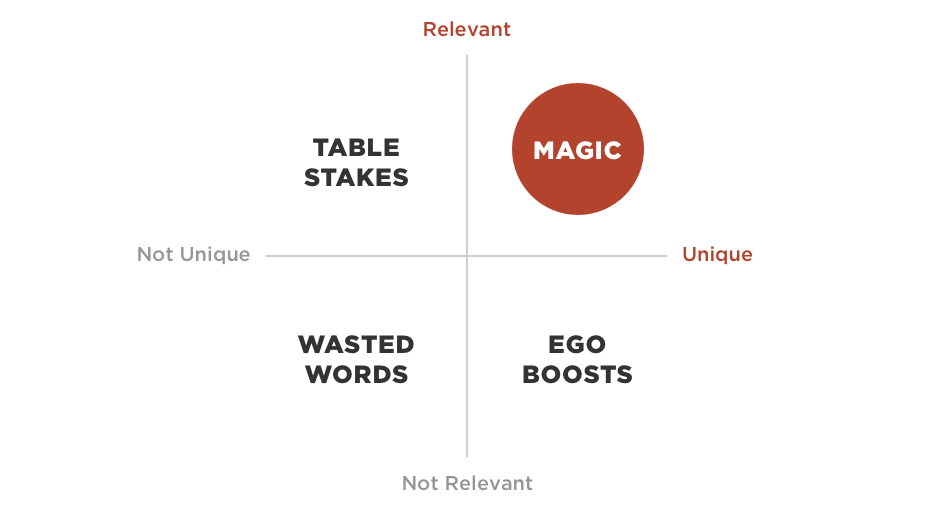
Here’s how it works:
- Write down all the qualities you think make your product or brand different from your competitors and peers. Put each quality on an individual Post-It Note.
- Then, take a look at your competitors’ and peers’ marketing (their website, product, collateral, packaging, email newsletters, etc.). What messages are they using to promote their brand? What do they say makes them different? (Remember: It doesn’t matter whether they actually follow through with those promises because, sadly, a potential customer doesn’t know if it’s the truth or not.)
- Next, refer back to your empathy maps to learn which qualities your customers care about most. What’s most important to them? Which qualities are game-changers that would cause them to pick you over others?
- Finally, place the Post-It Notes into the appropriate quadrant of your matrix based on how unique each characteristic truly is (see question #2) and how relevant it is to your audience (see question #3).
The characteristic that ends up farthest in the top right corner is the one your story should highlight.
Brainstorm with a Content Strategist or Copywriter
Sometimes, all it takes is a talented wordsmith to articulate your idea. Content strategists are particularly good at organizing information and making sense of multiple ideas. Copywriters are experts at finding the right words to convey your message and persuading the reader to take action. Either one is a great resource for taking all of the ideas generated in the exercises above and finding the most succinct, engaging way to say them.
What’s Your Story?
From day one, Airbnb never led with features or benefits. They’ve always focused on one thing: real experiences, including the experience of traveling like a human (their story from 2008-2009), belonging anywhere (2013-14), living like a local (2016), and more. Their design may have changed many times over, but one thing has stayed the same: their talent for telling a compelling, consistent story to their customers, investors, employees, and everyone in between.
Airbnb’s storytelling skills have catapulted them from fledgling startup to a global powerhouse worth over $30 billion (and growing). How might you harness the power of storytelling to emulate their success?
P.S. If you’re interested in trying some of the exercises in this article or need help telling your story, let’s chat. Drawbackwards’ team has content strategists, writers, design thinkers, and other pros that can uncover your true story, along with the right words, services, visuals, voice, and tone to tell it.